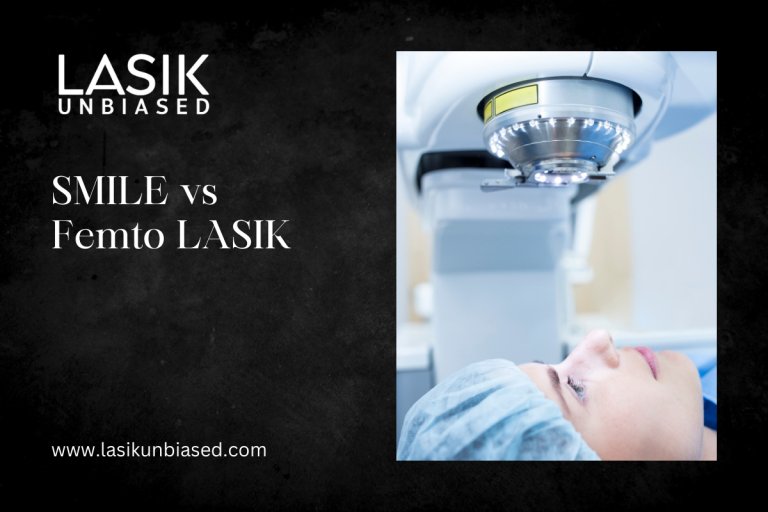SMILE vs. Femto LASIK: A Comparison of Two Advanced Vision Correction Procedures
Regarding correcting refractive vision problems such as nearsightedness, farsightedness, and astigmatism, two of the most advanced laser eye surgeries are SMILE (Small Incision Lenticule Extraction) and Femto LASIK. Both of these procedures are highly effective and use cutting-edge technology to improve vision, but they differ in technique, recovery, and ideal candidates. In this article, we will compare SMILE and Femto LASIK, highlighting each treatment’s benefits, differences, and suitability.
What Is Femto LASIK?
Femto LASIK is an advanced form of LASIK (Laser-Assisted in Situ Keratomileusis) surgery that uses a femtosecond laser to create a corneal flap instead of a microkeratome (a blade). This laser is exact and allows the surgeon to make a thinner and more customized corneal flap for the procedure.
After the flap is created, the underlying corneal tissue is reshaped with an excimer laser to correct the refractive error. Once the reshaping is done, the flap is repositioned without stitches, and the cornea heals naturally. Femto LASIK is popular because it offers greater precision, reduces the risk of complications, and has a fast recovery time.
What Is SMILE?
SMILE is a newer, minimally invasive laser vision correction procedure that uses a femtosecond laser but differently. Instead of creating a corneal flap, as in Femto LASIK, SMILE involves making a small incision in the cornea through which a tiny disc of tissue, known as a lenticule, is removed. The surgeon then uses the femtosecond laser to reshape the cornea by removing this lenticule, correcting the refractive error. The incision used in SMILE is much smaller than the flap created in Femto LASIK, which leads to certain advantages in healing and recovery.
Key Differences Between SMILE and Femto LASIK
While both SMILE and Femto LASIK have the same goal of improving vision and reducing or eliminating the need for glasses or contact lenses, they differ in several key aspects. Here are the significant differences:
1. Procedure Technique
- Femto LASIK: A femtosecond laser is used to create a flap in the cornea, which is then lifted to expose the underlying tissue. Afterwards, the flap is replaced over the treated area.
- SMILE: on the other hand, SMILE involves making a small incision in the cornea. The femtosecond laser creates a lenticule (a small disc of tissue) inside the cornea, which is removed through the incision. This technique does not require the creation of a corneal flap.
2. Incision Size
- Femto LASIK: The incision in Femto LASIK is relatively larger, as it requires creating a corneal flap that needs to be carefully repositioned after the treatment.
- SMILE: SMILE requires only a small incision, typically about 2-4 millimetres in size, which is much smaller than the flap created in Femto LASIK. The smaller incision reduces the risk of complications and may contribute to faster healing.
3. Recovery Time
- Femto LASIK: The recovery time for Femto LASIK is typically quick. Most patients experience noticeable improvements in vision within a few hours or days after surgery. However, since the procedure involves lifting and repositioning a flap, there is a slight risk of flap-related complications during the healing process, such as flap dislocation or wrinkles.
- SMILE: SMILE offers a faster recovery than Femto LASIK due to the smaller incision and the fact that no flap is created. This means there is a lower risk of flap complications, and patients often experience less post-surgery discomfort. Most people can return to normal activities within a few days, although full recovery may take longer.
4. Suitability for Candidates
- Femto LASIK: Femto LASIK is ideal for individuals with mild to moderate refractive errors. It can treat nearsightedness, farsightedness, and astigmatism. It suits people with healthy corneas and no severe dry eye problems. However, the procedure may not be recommended for those with thin corneas, as it requires the creation of a corneal flap.
- SMILE: SMILE is also effective for treating nearsightedness and astigmatism but has a slight edge regarding suitability for individuals with thinner corneas. Since there is no flap creation, SMILE can be a better option for those with corneas that may not be thick enough for Femto LASIK. It is also a good choice for individuals at higher risk for dry eyes after LASIK.
5. Visual Outcomes
Femto LASIK and SMILE offer excellent visual outcomes, with many patients experiencing 20/25 vision or better after surgery. The long-term success rates for both procedures are comparable, though some studies suggest that SMILE may result in slightly fewer cases of dry eyes post-surgery due to its flap-free nature.
6. Risk of Dry Eyes
- Femto LASIK: One of the more common side effects of LASIK procedures, including Femto LASIK, is dry eyes. Creating a corneal flap can interfere with the nerves that control tear production, leading to temporary or, in rare cases, persistent dry eye symptoms.
- SMILE: SMILE has a lower risk of dry eyes because it doesn’t involve creating a flap. The smaller incision preserves more of the corneal nerves, which helps maintain tear production and minimizes the risk of dry eyes after surgery.
7. Long-Term Safety and Effectiveness
Femto LASIK and SMILE have been proven safe and effective with long-term success. However, Femto LASIK has been in use for a longer time, which means more data on its long-term outcomes is available. SMILE, while newer, has shown promising results, and studies indicate that it may offer comparable or even superior results for some patients.
Which Procedure Is Better for You?
Choosing between SMILE and Femto LASIK depends on several factors, including the thickness of your cornea, the severity of your refractive error, and your risk of developing dry eyes. Both procedures are excellent choices for vision correction, but each has unique advantages.
- If you have a thin cornea or are at a higher risk for dry eyes, SMILE may be the better option since it does not involve creating a corneal flap and is less likely to disrupt tear production.
- If you have moderate refractive errors and are looking for a procedure with a proven track record, Femto LASIK may be the right choice.
Ultimately, the decision should be made in consultation with an experienced ophthalmologist who can evaluate your needs, eye health, and vision goals. Your surgeon will help determine the best eye procedure and guide you through the entire process.


